As US regulators give the green light, traditional Wall Street institutions quietly buy up, Vitalik has accumulated several Ethereum L1 expansion ideas, and the Federal Reserve secretly points the finger towards interest rate cuts - all grand narratives are converging on the same main line: Ethereum.
The four-wheel drive of regulatory thawing, technological iteration, macro trends and ultrasonic monetary mechanism are paving an acceleration runway for the next 3 to 18 months.
The ETH ETF net inflow curve continues to hit new highs, the gas fee on the block browser is about to exceed 5 million, and Ethereum has returned to the weekly MA 200; the on-chain pledge rate is approaching 30% and is still rising. From the North American Ethereum version of MicroStrategy SharpLink writing ETH into the balance sheet, to Robinhood announcing that the European region can use Ethereum L2 to trade on-chain U.S. stocks, to Hong Kong’s announcement to accept ETH as proof of immigration assets, the core value of Ethereum is becoming a global consensus.
Political games, capital momentum, protocol improvements, and foundation reform iterations are all happening simultaneously - there is only one key question left in the market: Are you ready?
The following 10 reasons will break down layer by layer how ETH leapt from industry consensus to a cross-cycle explosive engine.
1. The biggest regulatory benefit and policy in history
The dramatic shift in US regulatory stance has brought new optimism to Ethereum. The new chairman of the US Securities and Exchange Commission (SEC), Paul Atkins, has expressed support for crypto innovation - a stark contrast to the Gary Gensler era.
Atkins has withdrawn his Gensler-era proposals for decentralized finance and self-custody, and has instead adopted an “innovation first” strategy. In a recent roundtable, Atkins even emphasized that developers should not be punished for writing decentralized code.
It’s a major policy U-turn: The SEC under Gensler had considered Ether an “unregistered security” and investigated it. Now, under pro-crypto leadership, Ethereum enjoys a clearer regulatory outlook. As decentralized finance gains recognition at the highest levels — Atkins called self-custody “a fundamental American value” — the threat of hostile regulation has significantly diminished, greatly encouraging institutional participation in the Ethereum market.
Additionally, recent legislative developments in the United States, particularly the Senate’s GENIUS Act, mark a critical turning point in regulatory clarity for crypto-dollar stablecoins.
These bills aim to establish a clear framework for payment stablecoin issuers, which will give Ethereum’s adoption a strong boost given its status as the primary settlement layer for regulated stablecoins such as USDC and PYUSD, as well as one of the most important public chains for the largest stablecoin, USDT:
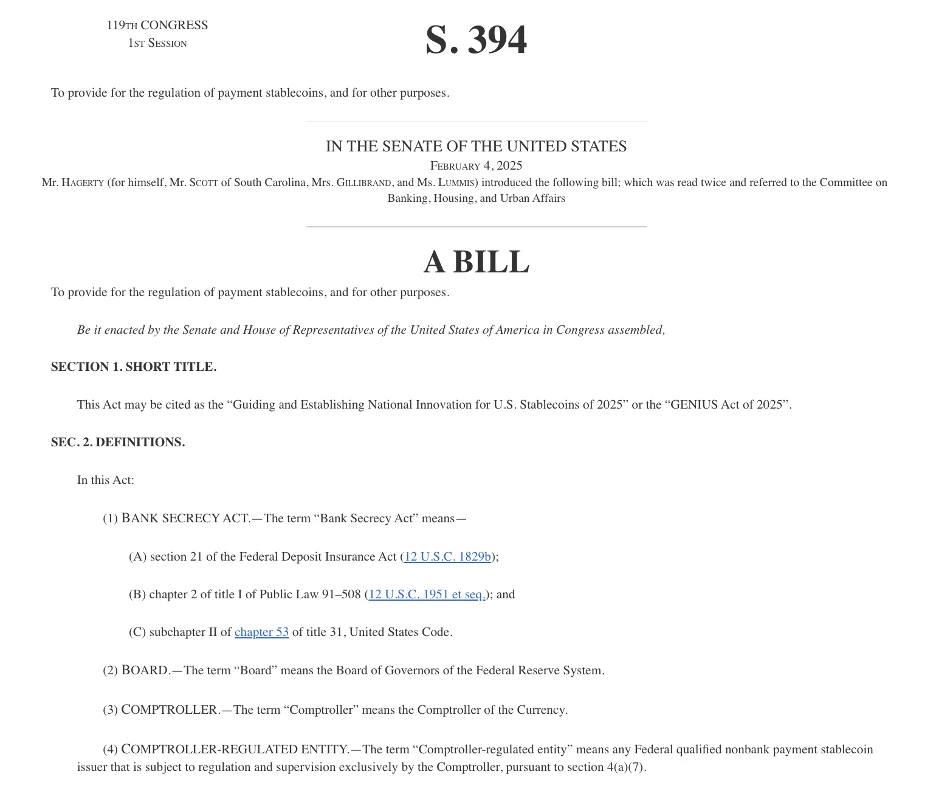
Source: US Congress
Comprehensive stablecoin framework
The Guiding and Establishing a National Innovation for Stablecoins in the United States Act (GENIUS Act) passed the Senate in June 2025 with bipartisan support. It imposes strict standards on stablecoin issuers, requiring 100% cash or Treasury reserve backing, monthly audit disclosures, and bankruptcy protection for token holders. Crucially, it allows banks and non-bank companies to issue stablecoins under license and be regulated.
Ethereum as Stablecoin Infrastructure
By explicitly legalizing and regulating stablecoin issuance, these bills validate dollar-backed tokens that primarily exist on the Ethereum network. For example, Circle’s USDC and PayPal’s PYUSD are ERC-20 tokens on Ethereum, relying on Ethereum’s security and global reach. The federal framework solidifies Ethereum’s role as a settlement backbone.
Lawmakers themselves acknowledge that well-regulated stablecoins could “strengthen the dollar’s position as the world’s reserve currency” while maintaining U.S. competitiveness. This mission inherently leverages public networks like Ethereum (where USD stablecoins circulate in DeFi and payments).
DeFi and USD Liquidity
Ethereum’s DeFi ecosystem, from lending protocols to decentralized exchanges (DEX), runs on stablecoin liquidity. By legalizing stablecoins, the GENIUS Act effectively secures the foundation of DeFi. Participants can use assets like USDC with greater confidence, without worrying about sudden crackdowns or legal ambiguity.
This encourages institutional participation in DeFi (e.g., using stablecoins for trading, lending, payments). In short, the legislation bridges traditional finance (TradFi) and DeFi: it invites banks, payment companies, and even tech companies to issue and use Ethereum-based stablecoins, while providing guardrails (KYC/AML, audits, redemption rights) to reduce systemic and legal risks. The net effect is a supportive policy environment that anchors Ethereum’s role in the digital dollar economy.
Finally, another encryption bill, the CLARITY Act (HR 3633), has also made considerable progress recently.
The CLARITY Act was first advanced by the House of Representatives. On June 13, 2025, the bill was passed by the Financial Services Committee and the Agriculture Committee with votes of 32:19 and 47:6 respectively. Currently, the bill has entered the Rules Committee process and is waiting to be submitted to the full House of Representatives for a vote.
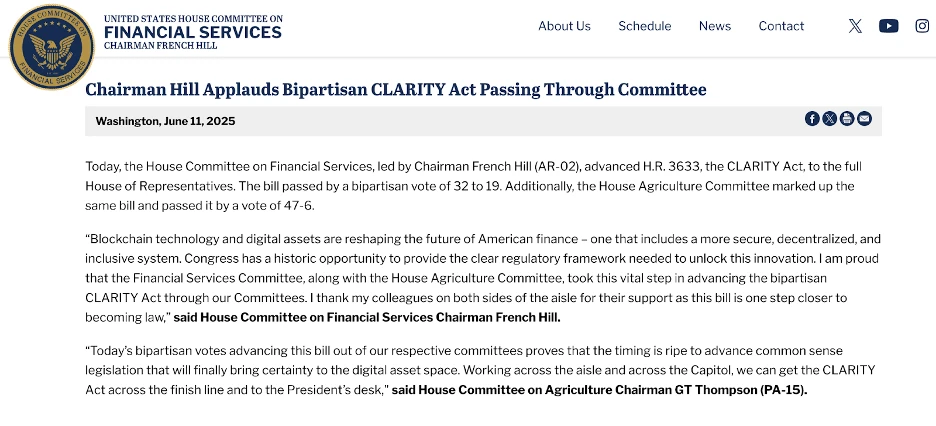
Data source: US Financial Services
The CLARITY Act removes the biggest question hanging over Ethereum in the United States: whether ETH is a security.
By explicitly classifying ETH (and any sufficiently decentralized Layer-1 token) as a “digital commodity” regulated by the CFTC, the bill precludes retroactive SEC enforcement, creates a safe harbor for secondary trading, and clarifies when developers and validators are not “brokers.” This combination significantly reduces regulatory risk premiums, paves the way for Wall Street products related to spot and staked ETH, and gives the green light for DeFi to continue innovating on the network.
In summary, given Ethereum’s dominance in custodial stablecoins and DeFi, these multiple regulatory green lights greatly strengthen the prospects for medium-term adoption, transaction growth, and Ethereum’s integration into the traditional financial system.
2. “ETH version of MicroStrategy” leads the competition among institutions
More and more big money players are looking at Ethereum as a strategic asset, a trend accelerated by a notable move by SharpLink Gaming. Nasdaq-listed SharpLink recently completed a milestone capital allocation: it acquired 176,000 ETH (about $463 million) and made Ethereum its primary reserve asset, becoming the worlds largest public ETH holder overnight. Currently, more than 95% of this asset has been staked to earn returns and enhance the security of the Ethereum network.
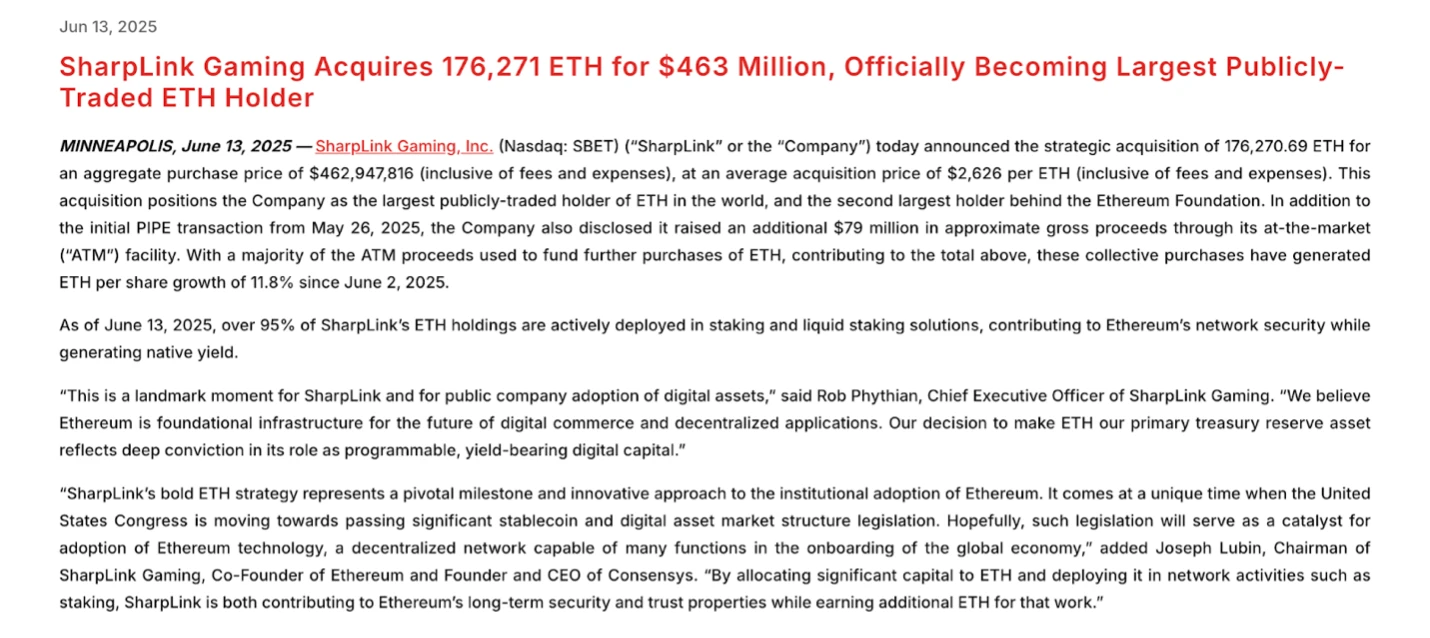
Content source: SharpLink Gaming
SharpLinks CEO called this a landmark moment and explicitly compared the strategy to MicroStrategys Bitcoin strategy, but with Ethereum instead. This bold financing was strongly supported by Joseph Lubin, founder of ConsenSys and one of the eight co-founders of Ethereum, who has become the new chairman of SharpLink. Lubin has stated on different occasions: SharpLinks bold ETH strategy marks a milestone in institutional adoption of Ethereum, and pointed out that ETH not only has Bitcoin-like value storage properties, but also has become a truly productive reserve asset due to its predictable scarcity and continuous returns; as Ethereum increasingly becomes the underlying architecture of the digital economy, ETH is also seen as a strategic investment in the future financial architecture.
Cryptocurrency treasuries have suddenly become a trend: SharpLinks success (its stock price soared 400% after the announcement) has prompted peers to emulate this strategy. The listed company Bitmine Immersion (BMNR) also recently announced that it has raised $250 million specifically for the purchase of ETH, positioning itself as an Ethereum treasury strategy company. Bitmine is led by Fundstrat co-founder Tom Lee. Its stock price soared more than 3,000% in the week after the announcement, attracting investment from many first-tier institutions such as Founders Fund, Pantera, and Galaxy.
Meanwhile, observers report that several companies, including in Europe, are also exploring Ethereum-focused reserve allocations. While some forward-looking companies such as BTCS Inc. have already begun holding ETH before, SharpLink’s move represents a new level of mainstream adoption.
For Ethereum, the increasing accumulation of ETH in corporate treasuries is undoubtedly a positive - it locks up supply (especially since most tokens will eventually be staked) and sends a signal of institutional confidence.
At the same time, institutions are also making arrangements through funds: the first Ethereum futures ETFs will be launched at the end of 2024, and the approval of the spot Ethereum ETF is just around the corner, which may release billions of dollars of new demand. Larry Fink, CEO of BlackRock, said in an interview with CNBC: I think there is value in launching an Ethereum ETF. This is just the first step towards asset tokenization, and I really believe that this is our future direction.
What can be seen is that Ethereum is increasingly being viewed by listed companies and funds as a strategic investment and reserve asset, similar to the development trajectory of Bitcoin in the previous cycle.
3. Weekly technical indicators return to MA 200
Ethereum’s price chart is showing multiple bullish technical signals, suggesting a possible trend reversal to the upside.
After a long period of slump, in May 2025, ETH regained its position above the weekly MA 200 - one of the most classic indicators of a bull market return.
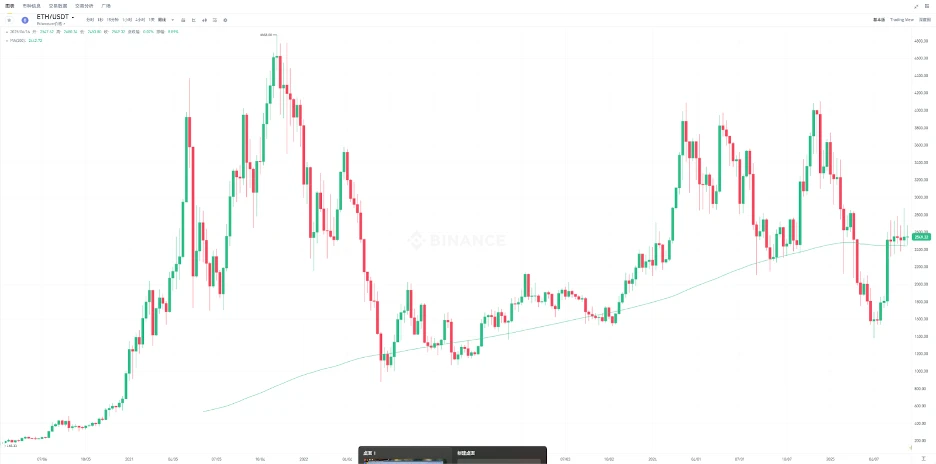
Data source: Binance ETH weekly MA 200
From a technical perspective, Ethereum’s overall market structure has improved: a series of lower lows has gradually given way to higher lows and a breakout of a long-term descending channel.
From May to June, ETH was sitting above its 200-week moving average, which (around $2,500) has become a support “launch pad” — ETH is bottoming above it, similar to the recovery phase of past cycles.
Momentum indicators confirm the positive structure: the weekly candlestick chart shows a long body and light shadows, indicating strong buying and less selling pressure on pullbacks. The rising slope of key moving averages and the re-trending MACD indicator show increasing upward momentum. In addition, we are also seeing bullish chart patterns - for example, multiple analysts pointed out a potential bull flag pattern on the ETH chart, which, if confirmed, could target upside above $3,000 in the medium term.
This suggests that traders are confident that ETH is well on its way to the downside and that the path of least resistance is to the upside. Overall, Ethereums technical picture of re-establishing its 200-week moving average, higher highs and lows, and increased momentum suggest that the asset is in the early stages of a significant bullish reversal, supporting a positive outlook for the next 3 to 18 months.
4. Ethereum Pectra Upgrade Rapid Advancement Roadmap
Ethereums technical roadmap is progressing steadily, continuously enhancing its fundamental value. The Pectra upgrade (Prague + Electra hard fork) launched on May 7, 2025 marks the entry of Ethereum into a new phase. The 11 EIPs it contains cover improvements in all aspects from smart wallets to scalability.
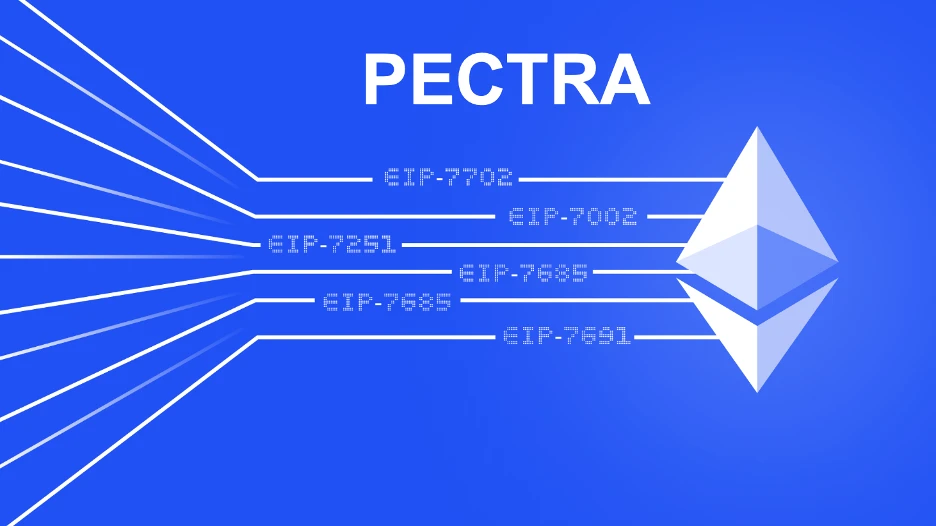
The most iconic changes include: increasing the upper limit of a single validators stake from 32 ETH to 2048 ETH, and recalibrating fees to significantly increase Layer-2 throughput. These changes reduce costs, improve L2 performance, accelerate the adoption of optimistic Rollups and zk-Rollups in the ecosystem, and clear obstacles for future L1 expansion.
At the same time, the Pectra upgrade supports account abstraction, such as gas-free payment, batch transactions, etc., which lays the foundation for the large-scale adoption of stablecoins in the future, and further widens the gap with other public chains in user experience and flexibility. As Ethereum core developer Tim Beiko summarized on April 24: A highlight of Pectra is EIP-7702, which makes use cases such as batch transactions, gas payment and social recovery possible without migrating assets.
At the main network level, Ethereum is also gradually increasing the Gas Limit from the initial 15 million to 36 million, and further to 60 million in the future, which has increased the number of transactions that Ethereum L1 can process per second by 2-4 times to 60 TPS. It can be predicted that after multiple expansions, Ethereum is expected to break through the three-digit TPS. Ethereum researcher Dankrad Feist even proposed: We have a blueprint to increase the Gas Limit 100 times in four years, which can theoretically increase Ethereum TPS to 2,000.
Meanwhile, Ethereum is actively moving forward with zero-knowledge (ZK) integration as part of the “Surge” roadmap phase. Upgrades like Pectra (and the upcoming Fusaka) lay the foundation for full ETH ZK-ification and ZK-validating light clients.
Clearly, Ethereum’s core protocol is evolving rapidly, keeping it technologically ahead of its competitors.
5. The macro environment is favorable with interest rate cuts imminent
The changing macroeconomic environment will favor Ethereum in the coming months. After a year of high interest rates, the market expects the U.S. Federal Reserve to shift to lower interest rates, which could push the benchmark yield below the return on ETH staking.
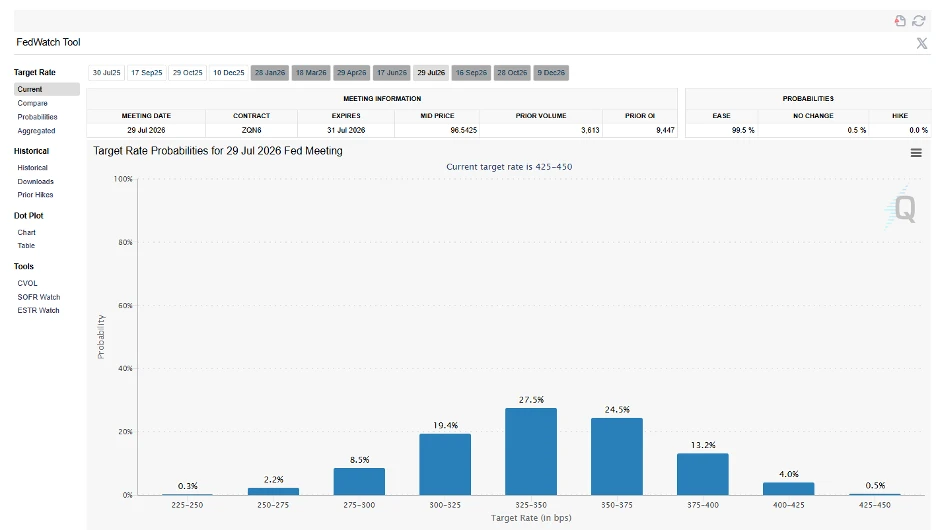
Data source: CME Fed Watch
According to CME Fed Watch, the federal funds rate will fall to 3.25% or lower by mid-2026. At the same time, the Ethereum chain’s staking yield (currently about 3.5% annualized interest rate) is expected to rise due to increased network activity and fees.
This convergence of trends creates a “double-hit effect”: traditional risk-free rates fall while Ethereum’s native yields rise, potentially turning the spread between ETH staking and Treasury yields positive.
If Ethereum staking can provide returns significantly higher than U.S. Treasuries or savings accounts, it will enhance the appeal of ETH as a high-yield and liquid asset. Not only does staking bring a solid return, but ETH itself also has the potential to rise, which is an attractive combination for investors who have difficulty obtaining returns elsewhere.
Additionally, it is well known that more accommodative Fed policy (and an improving inflation outlook) tends to weaken the dollar, which has historically been beneficial for all crypto assets.
Such an accommodative monetary policy macro trend is very favorable for ETH in the next 3 to 18 months time frame.
6. Staking: On-chain staking and ETF staking in tandem
Justin Drake, a core researcher at Ethereum, pointed out in multiple podcast interviews between 2024 and 2025: “Ethereum staking has become fundamental to network security and economic models. If the United States approves a staking ETF, it may bring billions of dollars of new institutional demand.”
Ethereum’s transition to Proof of Stake (PoS) has opened up new dynamics around staking, and U.S. regulators are slowly becoming open to investment products that leverage staking returns. With the SEC approving multiple spot Ethereum ETFs in 2024, the stage is set for the next phase of innovation: a U.S. staking ETF that provides exposure to ETH plus staking returns.
Therefore, Ethereums future staking will become a two-pronged approach:
1. Traditional Institutional Staking : How a staking-enabled ETF might impact Ethereum’s ecosystem and value;
2. On-chain protocol staking : The role of protocols like Lido and Ether.Fi in popularizing staking.
Growing staking participation: Ethereum staking has experienced strong growth following the Merge and Shanghai upgrades. As of Q1 2025, approximately 28% of the total ETH supply is staked in validator nodes, a record high, reflecting strong confidence in the network.
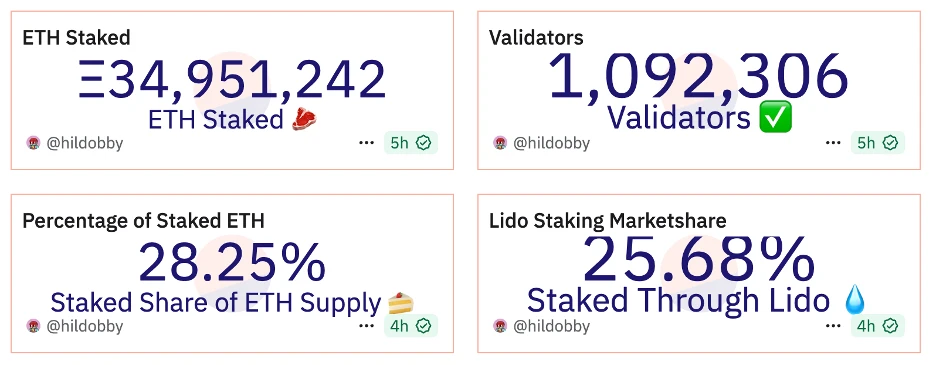
Data source: Dune https://dune.com/hildobby/eth2-staking
On-chain staking: Multiple positions are advancing together to crack the centralized staking
It is worth noting that ETH Staking has not become centralized: Lido Finance is still the largest single staking provider, but its once dominant market share (about 30% or more) has not continued to be concentrated. The reason is that Lido personally promoted the two major sectors of community staking (CSM) and DVT staking (SDVTM), which gradually increased their share in the Lido Staking pool, thus shattering the doubts that ETH Staking would soon become centralized.
At the same time, the staking landscape is becoming more diverse, with new platforms like Ether.Fi increasing ETH staked by about 30% in the past six months, with a net increase of more than 310,000 ETH in the past month alone. In particular, strategies related to revolving loans allow Ether.Fi to demonstrate how innovation can make Ethereum staking more accessible and capital efficient: users can easily participate with small amounts, maintain liquidity, and even amplify returns, all of which encourage broader staking participation.
Staking returns have changed investors considerations - ETH is no longer a non-yielding asset, but is gradually becoming similar to a productive asset, with returns comparable to dividends or interest, and even answered Buffetts question about the non-interest-bearing assets such as gold and Bitcoin. Overall, the number of staked ETH is still at an all-time high, indicating that holders view staking as an attractive long-term strategy (earning returns while protecting the network) rather than short-term speculation.
Expected US Mortgage ETFs and their impact
With spot Ethereum ETFs already trading in the U.S., a natural progression would be to launch an ETF that not only holds ETH but also participates in staking to earn yield. Such a product would be groundbreaking, providing traditional investors with exposure to ETH price appreciation and ~3-4% annualized staking returns in a single, regulated vehicle. If a U.S. ETF backed by staking is approved, the impact on Ethereum could be significant:
Increased demand and reduced circulation : Staking ETFs may attract institutional capital and retirement accounts that prefer the convenience of ETFs. This locks more ETH in the staking contract, effectively reducing the liquidity supply in circulation. A popular ETF may exert a push back on the price of ETH.
Verify the legality of staking : In particular, the new SEC chairman has made it clear that “validators, staking as a service” do not fall under securities jurisdiction, which sends a strong signal to U.S.-approved staking ETFs.
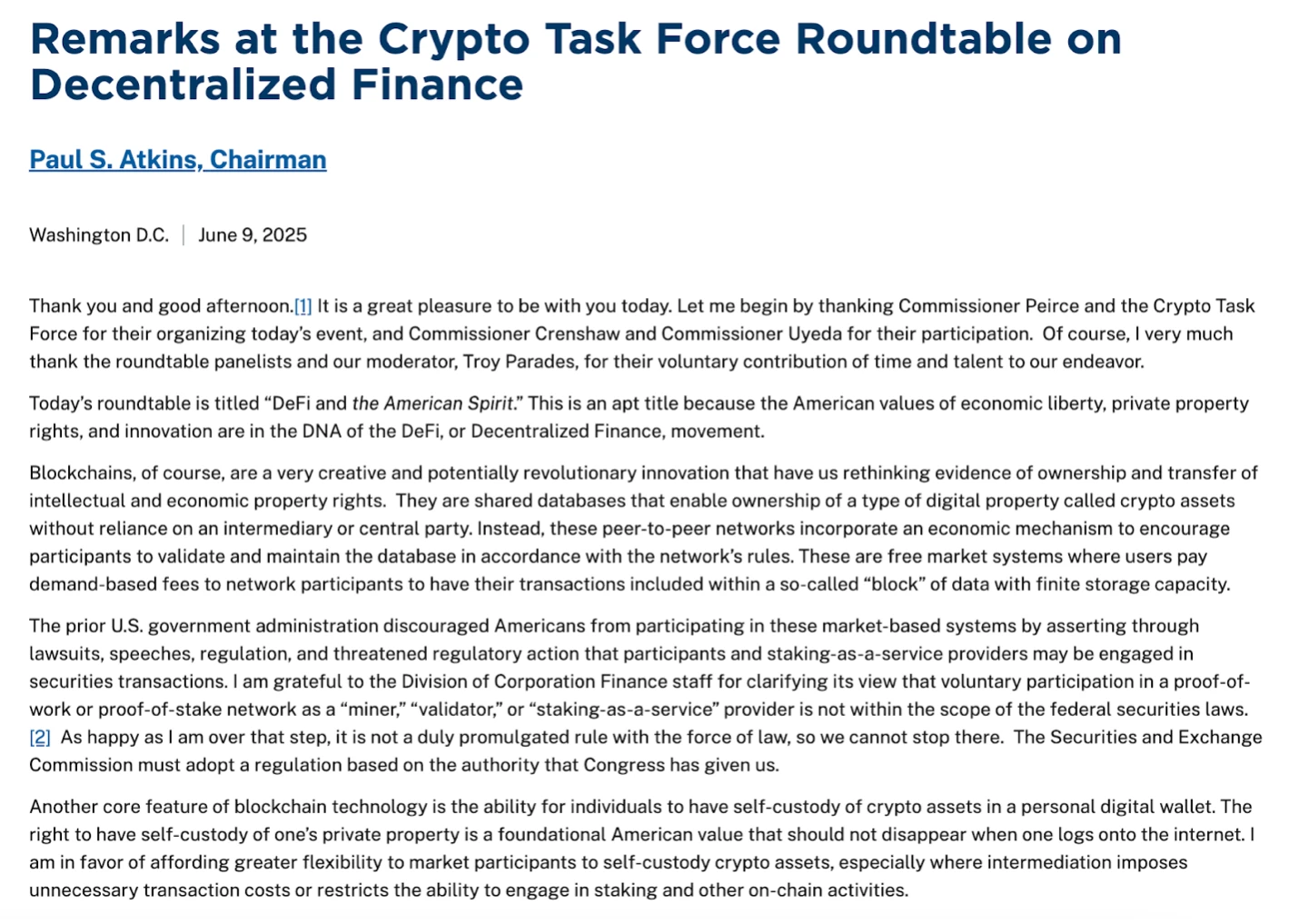
Data source: SEC
Industry experts like Bloomberg’s James Seyffart and ETF analysts at The ETF Store predict that the SEC could allow staking functionality to be included in ETFs for major assets like Ethereum by the end of 2025. In short, U.S. staking ETFs appear to be a question of “when, not if.”
Essentially, it normalizes staking in the eyes of traditional investors as a kind of “crypto dividend” or bond-like interest. This mainstream acceptance could expand Ethereum’s investor base, attracting not only growth investors but also those seeking yield and income.
In summary, Ethereum staking has become a core pillar of the networks value proposition, and the emergence of a US staking ETF could be a game changer. This growing staking base reduces circulating supply and encourages long-term holding, supporting the price of ETH. If regulators allow ETFs to integrate staking, it will invite a new class of investors to participate in Ethereums returns within a familiar framework, potentially boosting demand for ETH and strengthening its position as a yield asset.
Allen Ding, founder of Ebunker, said: “As a top staking service provider in Asia, I would like to talk about the potential of Ethereum from the perspective of nodes. Ethereum currently has more than 1 million nodes and thousands of node entities. It is one of the most decentralized protocols in the entire blockchain industry and even in all organizations in the entire human society.
Although Ethereum has performed poorly in terms of application ecosystem prosperity and user growth in recent years, I believe that the long-term reputation accumulated in terms of decentralization and security is its real and unchallengeable moat. We have recently seen many commercial companies such as Robinhood still choose ETH L2 to issue its on-chain securities, which shows the indestructible position of Ethereum in peoples hearts.
So, I boldly say that Ethereum is unkillable — both literally and figuratively.”
7. Layer 2 adoption surges as thousands of chains compete to launch
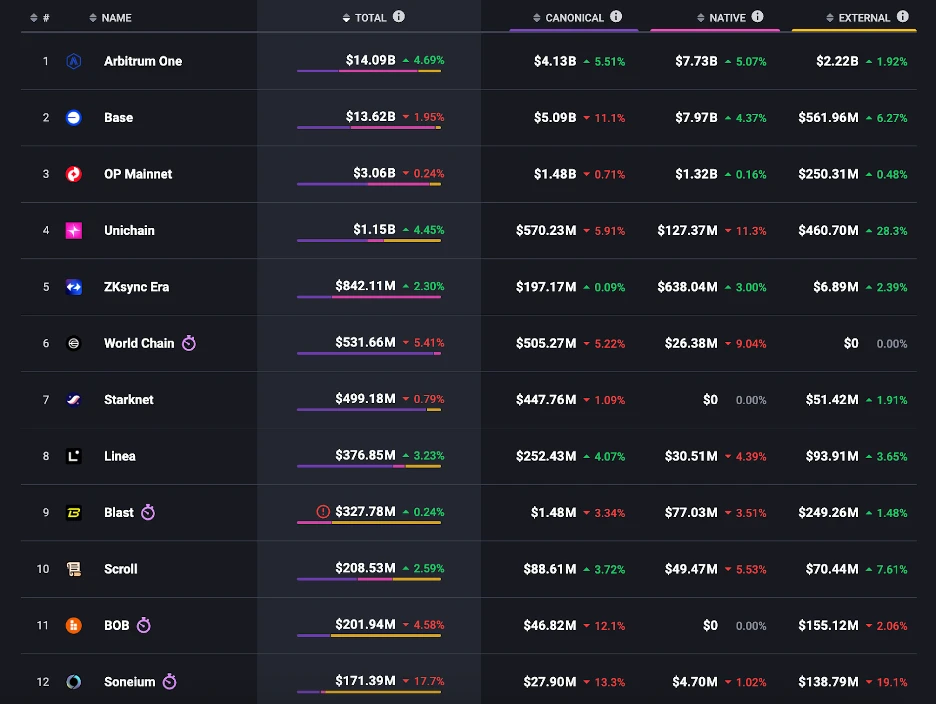
Data source: L2 Beats
Ethereum’s strategy of expanding through the Layer-2 network is achieving remarkable results. The L2 strategy eliminates many new “Ethereum killers” that might have emerged.
Rather than competing with every emerging blockchain, Ethereum is empowering them as L2, and even large enterprises are jumping on board. For example, Sony has launched its own Ethereum L2 blockchain, Soneium, which aims to bring Web3 to gaming, entertainment, and finance. Sonys platform will use Optimisms OP Stack technology, inheriting Ethereums security while providing customized scalability. This is the first time that a global consumer technology giant has built a platform directly based on Ethereums L2 framework, which greatly validates Ethereums strategy.
Recently, Robinhood also joined the ranks, announcing plans to build its own L2 blockchain based on Arbitrum to support its new business lines such as tokenized stocks and encrypted perpetual contracts launched in the European Union. As one of the hottest financial platforms in the United States, Robinhood’s participation marks the continued appeal of Ethereum’s L2 strategy to mainstream fintech companies.
Meanwhile, Base, the L2 network of US exchange Coinbase, has seen a surge in activity since its launch in 2024. Base processes over 6 million transactions per day, even surpassing traditional L2s such as Arbitrum in usage. In fact, as of the end of 2024, Base accounted for approximately 60% of all L2 transactions, demonstrating the potential for Ethereum L2 to achieve massive scalability with the support of large platforms.
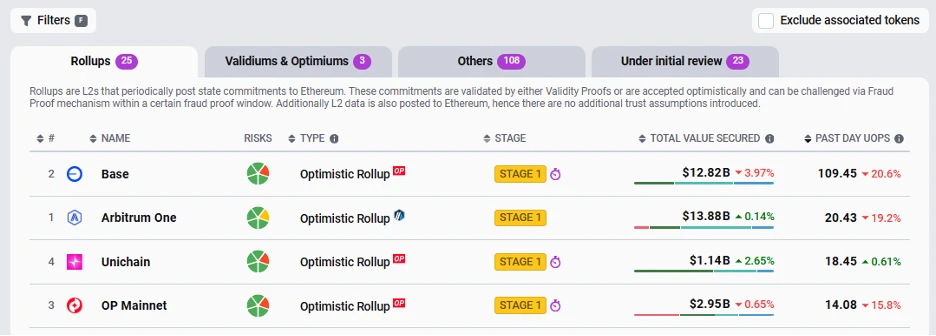
Data source: L2 Beats
Not to be outdone, Binance has also adopted Ethereum’s technology—its opBNB chain is based on Optimism’s L2, achieving over 4,000 TPS in testing and processing 35 million transactions during the beta period. By using Ethereum’s EVM and OP Stack, opBNB extends Ethereum’s influence to the BNB Chain ecosystem while maintaining compatibility.
The conclusion is: Ethereum’s network effects are so strong that it has enabled potential competitors and large enterprises to convert to become part of its L2 superstructure at an early stage. This widespread L2 adoption (from Sony to Robinhood, Coinbase to Binance) has driven more usage and fees back to Ethereum, underscoring its position as the preferred settlement layer.
8. Mainstream and political adoption
Beyond the price, signals from the broader ecosystem suggest that Ethereum is becoming increasingly woven into the fabric of technology, business, and even politics.
One notable example is the Trump family’s foray into crypto through a new platform called World Freedom Financial (WLFI). WLFI seeks to offer high-yield crypto services and digital asset trading — essentially bringing the DeFi concept to the masses.
Trumps son Trump Jr. publicly predicted that WLFI has the potential to reshape DeFi and CeFi and completely change the financial industry, and emphasized: We are just getting started. Before and after the tweet, WLFI spent $48 million to buy ETH to support its DeFi business.

The Trump family’s involvement — they reportedly own a majority stake in WLFI and have even named Trump himself “chief crypto advocate” — suggests that even traditional conservative figures are now beginning to see the value in Ethereum-based finance, which could be seen as an indirect endorsement of Ethereum technology.
At the same time, the attitudes of institutional investors are also undergoing fundamental changes.
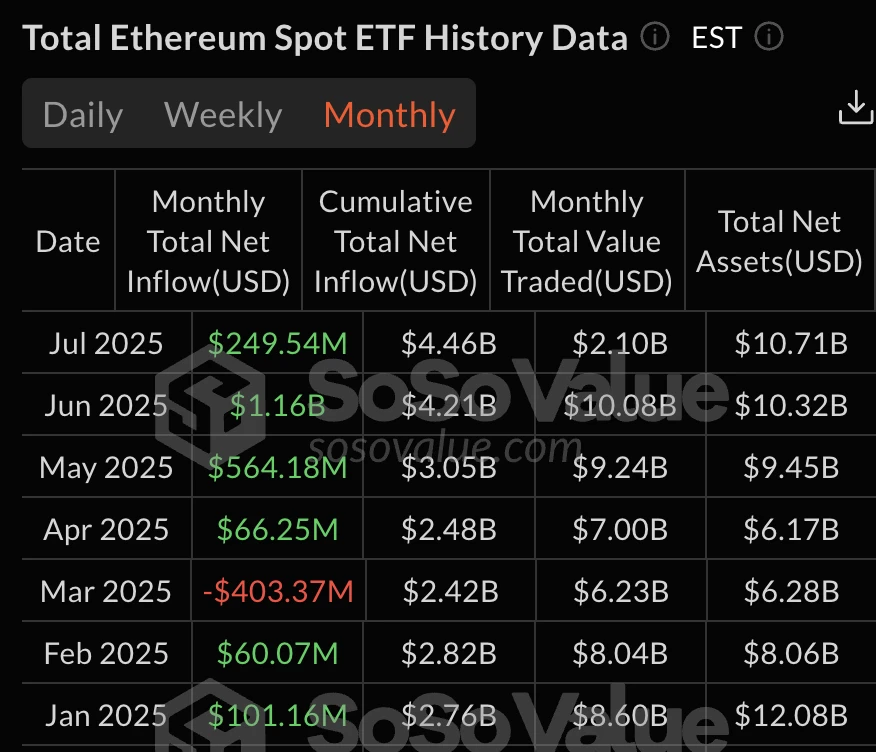
Data source: SoSoValue
In June 2025, the net inflow of Ethereum spot ETF exceeded 1.1 billion US dollars, setting a new monthly high since 2025, accounting for more than 27% of the current cumulative net inflow (4.18 billion US dollars), showing that institutional funds are rapidly and massively entering the Ethereum market. More importantly, this is not a short-term capital movement, but a continuous allocation trend:
As of June 12, 2025, the Ethereum spot ETF has recorded positive capital inflows for 19 consecutive trading days, breaking the record of continuous net inflows in the history of crypto ETFs; among them, the net inflow on June 11 was as high as US$240 million, which not only far exceeded the US$165 million of the Bitcoin ETF in the same period, but also highlighted that the markets preference for ETH is increasing.
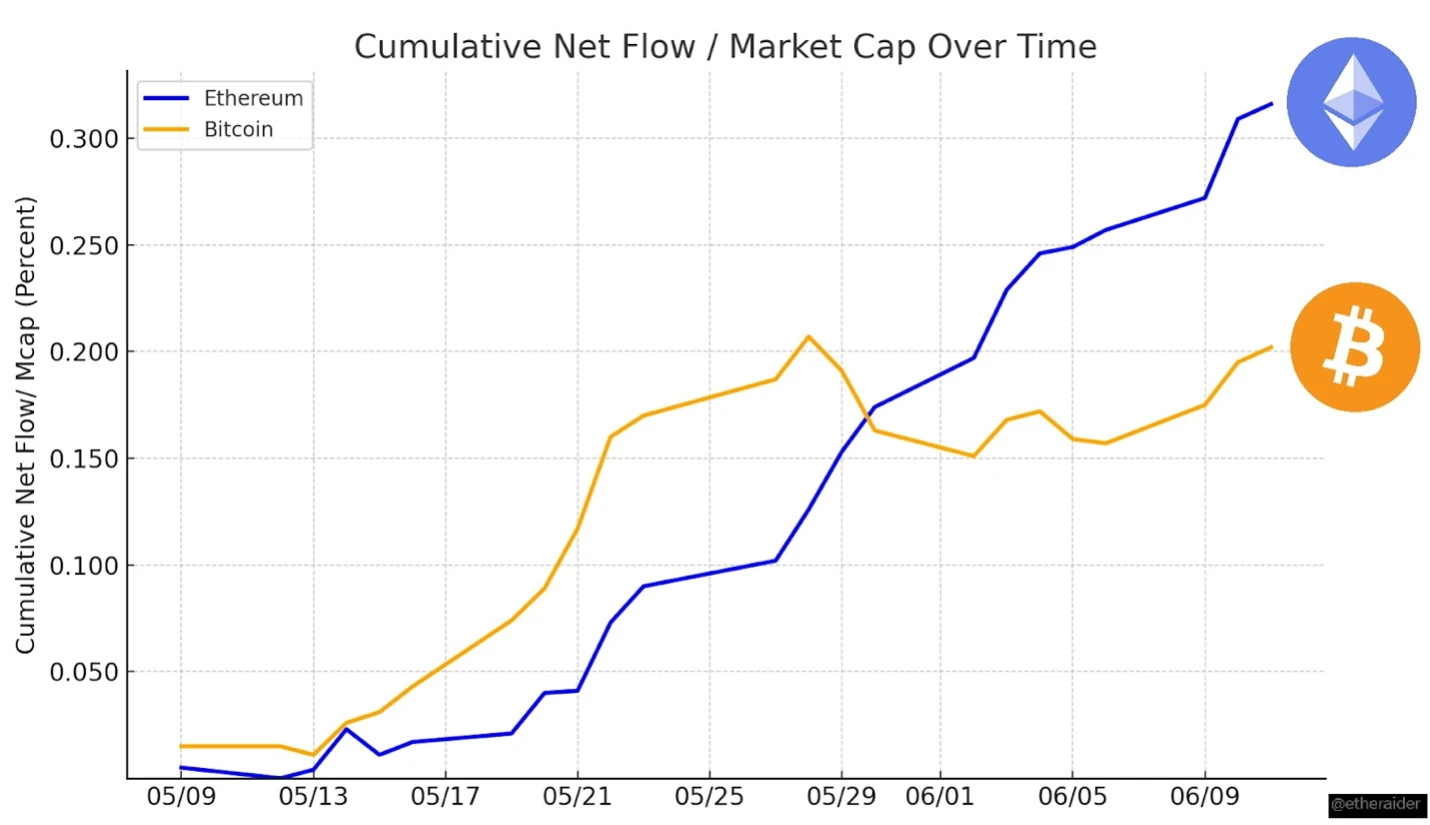
Data source: X @etheraider
This series of changes in capital flows sends a clear signal: institutions are no longer just paying attention to Ethereum, but are firmly allocating Ethereum.
The logic behind it is not complicated:
Ethereum has a diversified income structure (staking income, MEV capture, L2 profit sharing).
Have a more efficient technology upgrade path (such as EIP-4844, modular architecture),
And a continuously leading developer ecosystem and application vitality.
For institutions, ETH is no longer just a substitute for Bitcoin, but more like a proof of equity in the digital financial system - representing the underlying rights and interests of future global network finance. This shift in role positioning has driven ETH to gradually become one of the core assets in mainstream financial configurations.
Morgan Stanley analysts recently reiterated: If Ethereum can continue to upgrade smoothly, more institutional investment (such as a new round of ETFs) will continue to push ETH prices up. We still stick to our bold long-term target of $15,000.
Moreover, it also highlights the development of Ethereum: from being ignored by regulators and traditional forces to being adopted by the President of the United States. Other signals in the ecosystem are also everywhere: PayPal has launched an Ethereum-based stablecoin (PYUSD) and Visa is using Ethereum to settle USDC payments.
In addition, mainstream adoption in countries and regions outside the United States is also accelerating.
Since 2021, Europe, Asia and emerging markets around the world have also actively adopted Ethereum in the fields of policy, finance and technology:
Europe: After the MiCA regulations came into effect, Deutsche Bank, BNP Paribas and others used Ethereum as a digital bond issuance and settlement platform. French asset management giant Amundi made it clear that Ethereum is at the core of our digital securities strategy. In 2023, the London Stock Exchange (LSE) announced support for the listing of Ethereum-based digital assets. The SIX Exchange in Switzerland has launched Ethereum spot and derivatives since 2022.
Asia Pacific: In 2024, Hong Kong spot ETH ETF will be listed and support Staking. HashKey, OSL and other compliant exchanges use Ethereum as the underlying asset custody. Singapores DBS Bank has been conducting a pilot of Ethereum DeFi liquidity pool since 2022, with ETH as the core collateral. Japans Mitsubishi UFJ leads Progmat Coin, and the Ethereum-compatible architecture issues Japanese yen stablecoins. Australias eAUD is Ethereum-compatible EVM.
Latin America and the Middle East: Brazil’s Central Bank CBDC, the UAE, and Abu Dhabi promote asset tokenization and digital identity, with Ethereum and L2 platforms as their preferred platforms.
Africa: The Central Bank of Nigeria will partner with Consensys in 2022 to promote the eNaira national payment system based on the Ethereum architecture.
These cases show that Ethereum has become the preferred underlying platform for digital asset issuance, asset custody, compliance pilots and corporate innovation, whether in Europe and the United States, Asia, the Middle East or Africa.
As more and more governments, fintech companies and enterprises around the world integrate Ethereum into their actual businesses, the actual demand and reality of ETH will further improve the supply and demand structure, providing more room for the upward cycle in the next 3-18 months.
9. Vitalik’s continued promotion and the reform of the Ethereum Foundation
Ethereum has not only made continuous breakthroughs in technology and the market, but the organizations and thought leaders behind it have also entered a new stage of development. Vitaliks continued research, the reshaping of the foundation, the establishment of the Etherealize department, and the co-evolution of L1 and L2 have jointly pushed the Ethereum ecosystem towards a more mature and influential direction.
Vitalik: The only crypto leader after Satoshi Nakamoto
Vitalik Buterin is known as the only true god after Satoshi Nakamoto. He is not only the founder of Ethereum, but also continues to influence the ecosystem as a pioneer in industry research and a social media influencer. Currently, his focus includes:
ZK strategy: Vitalik has established zero-knowledge proof (ZK proof) as the core technology of Ethereum for the next decade. He continues to promote the dominance of ZK proof in expansion and security, while emphasizing that Ethereum cannot rely too much on a single technology route. Although the industry has achieved breakthroughs such as real-time ZK proof, Vitalik also reminded that performance optimization, auditability and ease of use are still shortcomings, and ZK proof will play a key role in the process of improving Ethereums efficiency and security in the long run.
RISC-V + ZK-EVM performance innovation: Vitalik advocates the use of a general RISC-V virtual machine as a long-term goal, and believes that if the mainnet can achieve this upgrade, the execution efficiency is expected to increase by 50-100 times or even higher. At the same time, ZK-EVM will serve as a mid-term transition and supplement. Through architectural innovation, Ethereum is expected to significantly lead similar public chains in verifiability and performance, and continue to strengthen its core competitiveness.
Light Node Roadmap: Vitalik promotes innovative ideas such as partial stateless nodes, allowing ordinary users to participate in network verification by only retaining the sub-states they care about, thereby lowering the hardware threshold and reducing the pressure of RPC centralization. This direction will help improve the level of decentralization and user participation of Ethereum, and lay a technical foundation for broader social participation in the future.
In the crypto space, his number of followers on Twitter is second only to CZ, and his personal voice is enough to influence the crypto industry and spark industry discussions. Vitalik continues to contribute in-depth research and cutting-edge discussions to the industry, demonstrating his absolute dominance as a blockchain thought leader.
Foundation Reorganization: Organizational Structure Optimization and Core Talent Promotion
In 2025, the Ethereum Foundation (EF) released a new organizational structure. Former Executive Director Aya Miyaguchi was promoted to President, focusing on global strategy and external relations; the board of directors is composed of Vitalik Buterin, Aya Miyaguchi, Swiss legal counsel Patrick Storchenegger and new director Hsiao-Wei Wang, responsible for long-term vision and compliance supervision.
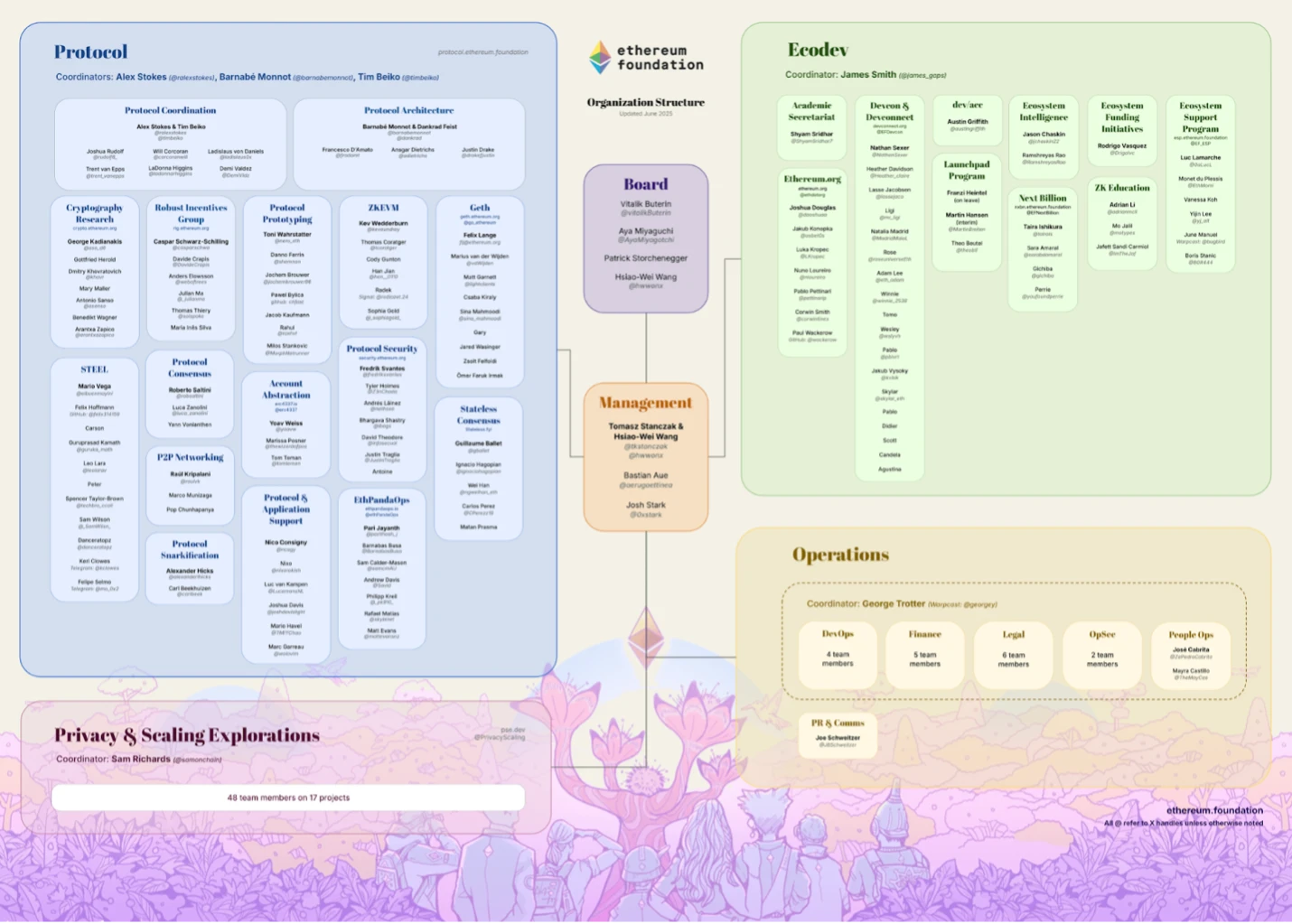
At the operational level, the Foundation introduced the Co-Executive Directors model for the first time: Hsiao-Wei Wang, former head of Protocol Support, and Tomasz Stańczak, founder of Nethermind, are jointly responsible for daily management; at the same time, Bastian Aue (organizational strategy, recruitment and training) and Josh Stark (project execution, market communication) joined the management team to form horizontal collaboration.
This reorganization will clearly separate decision-making power from executive power, forming a two-tier governance structure of board of directors-management, thereby dispersing single-point risks, improving execution efficiency, and providing a smoother collaboration channel for the three major sectors of core RD (Protocol Privacy Scaling), ecological development (Ecodev), and operational support.
Overall, EF is evolving from “single-line” management to a flatter, multi-center governance model, providing a solid foundation for Ethereum’s next stage of cross-L1/L2 expansion and multi-field collaboration.
Etherealize: A new breakthrough in Wall Street strategic docking
In January this year, an independent non-profit organization, Etherealize, was added to the Ethereum ecosystem. The organization is funded by the Ethereum Foundation, but remains independent in governance and operations, and is positioned as Ethereums institutional market and product hub. The Etherealize team is led by Vivek Raman, a senior Wall Street banker, and Danny Ryan officially joined as a co-founder in March.
Etherealize mainly provides research, education and product docking services to banks, securities companies and asset management institutions, focusing on promoting the practical application of asset tokenization, customizable L2 solutions and zero-knowledge privacy tools. The establishment of this organization means that the Ethereum ecosystem is moving from a simple technical community to financial infrastructure, and the specific lobbying for Wall Street has further consolidated ETHs position as an institutional-level digital asset.
Technical thinking shift: L1 and L2 coordinated development
While Ethereum is deepening its L2 expansion, it is also accelerating the improvement of the basic performance of the main network (L1). Vitalik Buterin pointed out in an interview with Decrypt on June 2 this year: I think we should expand the Ethereum main network by about 10 times in the next year or so.
The most intuitive progress is the dynamic increase in the Gas Limit. In 2024, the main network Gas Limit will be increased from 15 million to 36 million. After entering the voting stage in 2025, it is expected to increase to 60 million, bringing the peak TPS of the ETH main network to 60, which is four times the historical level.
Unlike Bitcoins fixed block size, Ethereums Gas Limit is dynamically adjusted by the validators of the entire network without the need for a hard fork, which improves the flexibility of on-chain governance and community participation. Recent radical proposals such as EIP-9698 suggest significantly increasing the Gas Limit in the next few years, but the community as a whole prefers to balance security, decentralization, and performance.
The latest tests show that the 60 million Gas Limit has a controllable impact on most node performance and block propagation latency, laying a solid foundation for future L1+L2 collaboration and serving hundreds of millions of users.
10. Token Economy: Ultrasonic Currency Still Works
Ethereums native token economics continue to strengthen its investment value. Ethereums ultrasonic currency theory is being realized: fee burning often exceeds new issuance, and even causes net deflation of ETH supply during high activity periods. Since the London upgrade, more than 4.6 million ETH have been burned, continuously reducing the circulating supply.
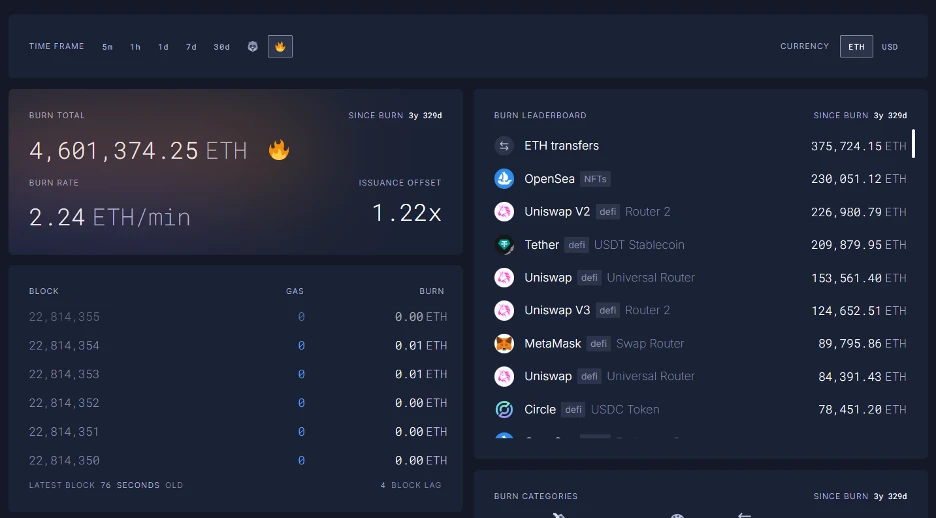
Data source: Ultrasound Money
From a supply perspective, higher staking participation does slightly increase protocol issuance (more validators = more reward ETH released), but since the switch to PoS, Ethereums issuance is still far lower than the Proof of Work (PoW) era - only about 700,000 ETH is newly issued each year (corresponding to 30 million staked ETH), which is far lower than the 4.5 million ETH per year under the old mining system.
From a consumption perspective, on-chain activity remains strong — Ethereum steadily processes billions of dollars in transactions per day, covering decentralized finance, NFTs, and payments, far more than any other smart contract chain. Despite the bear market, this healthy network usage suggests that Ethereum’s utility (and therefore demand for ETH as fuel) is on a solid upward trend.
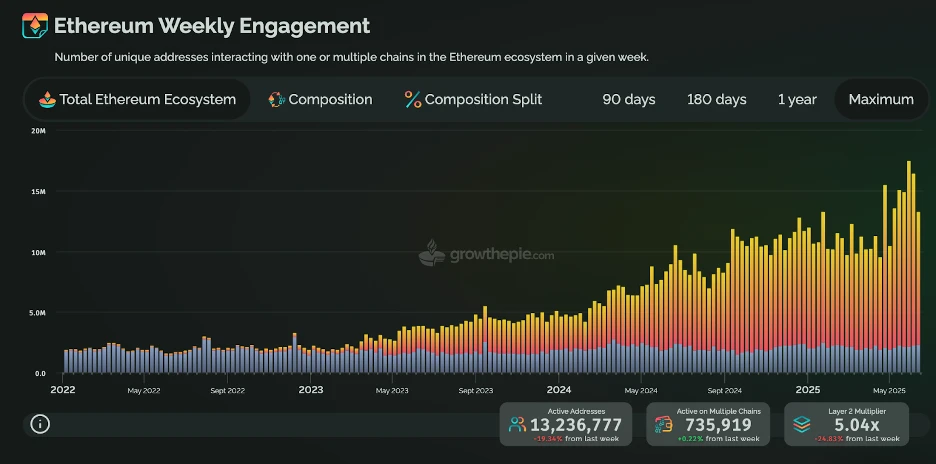
Data source: growthepie.com
Even at ~28% staking participation, annual ETH issuance via staking is only around 0.5–1% of supply, and with the EIP-1559 fee burn mechanism, periods of high network activity still see net deflation of ETH supply.
In fact, Ethereum’s net issuance hovers around zero, and is even deflationary at times, depending on network fees. With the burning mechanism offsetting fees, Ethereum’s monetary policy can be said to remain deflationary or neutral in many cases. Therefore, as staking grows, Ethereum’s “inflation rate” remains low and “yield” remains high, while more and more ETH is locked up to protect the network, achieving “have it all”.
As L2 adoption (as discussed above) drives more transactions to be settled on L1, Ethereum’s fee revenue (and thus ETH burn) should continue to grow. Overall, Ethereum’s supply and demand profile in the medium term is very bullish: effective supply is decreasing, and demand from network users and long-term stakers/investors is rising.
in conclusion
Looking at the four dimensions of regulation, technology, capital and macro, Ethereum is entering the compound interest zone at the turning point. When the policy ceiling is opened, the protocol performance continues to iterate, the institutional configuration shifts from trial to strategy, and the global liquidity is loosened again - these four forces are not isolated and superimposed, but coupled with each other and resonate exponentially.
History tells us that the assets that truly change the rules of the game often quietly complete the valuation reshaping before the consensus is fully solidified. Today, the ten core reasons have been arranged side by side, interpreting a clear timeline - from compliance release to treasury account, from Pectra upgrade to pledge ETF, from L2 expansion to deflationary monetary theory. All signals point to the same answer: ETH is no longer just an opportunity for the next stage, but the most certain increment at the moment. The market will eventually realize this logic with price - the only question is whether you will choose to turn the last page before or after the story is finished.
Ebunker official website: https://www.ebunker.io
For more discussion, please join: https://t.me/ebunkerio
Ebunker Twitter: https://twitter.com/ebunker_eth










